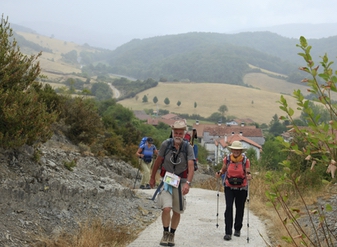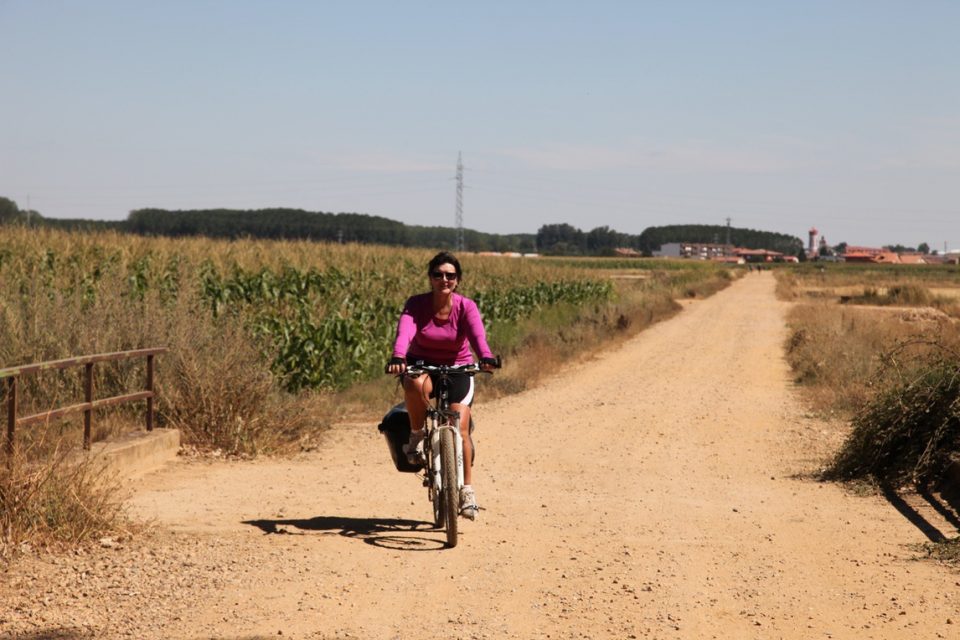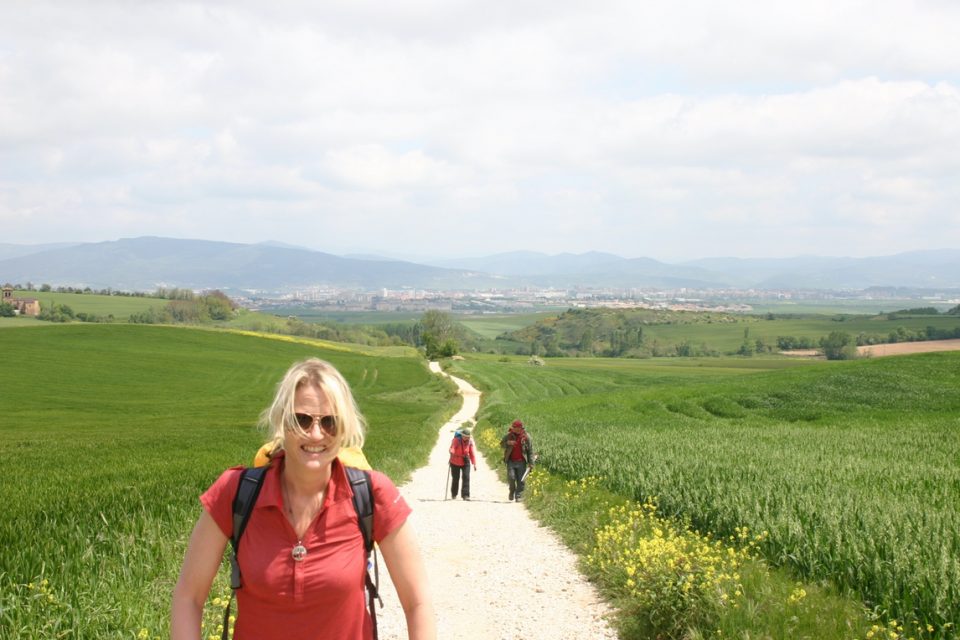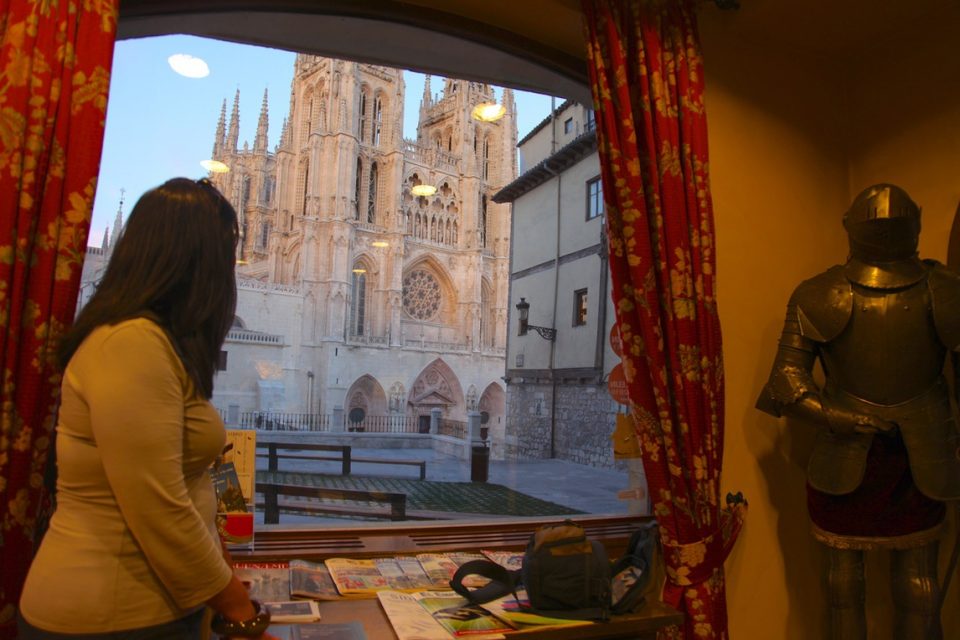length
35 Days
difficulty
Moderate
trip cost
From $6790 pp
Nature Immersion
Cultural Interest

Highlights
Get Ready For
- Follow in the footsteps of millions of pilgrims
- Over 1,000 years of history on the world’s greatest historical trail
- Enjoy a sip of wine at the famous wine fountain of Irache!
- Bring a rock from home to leave at the Cruz de Ferro
- Indulge the tastebuds, visit the Museo del Chocolate in Astorga
- Finish your pilgrimage walk into the incredible city of Santiago de Compostela
Itinerary
Daily Details
Day 1: Arrive in St. Jean Pied de Port
Day 2: Walk St Jean Pied de Port to Roncevalles (25km)
Day 3: Walk Roncesvalles to Zubiri (22km ) or Akerreta (28km)
Day 4: Walk Akerreta to Pamplona (17km)
Day 5: Rest day in Pamplona
Day 6: Walk Pamplona to Puente de la Reina (24km)
Day 7: Walk Puente de la Reina to Estella (22km)
Day 8: Walk Estella to Los Arcos (22km)
Day 9: Walk Los Arcos to Logrono (28km)
Day 10: Rest day in Logrono
Day 11: Cycle from Logrono to Santo Domingo de La Calzada (50km)
Day 12: Cycle Santo Domingo to Villafranca Montes de Oca (35km)
Day 13: Cycle Villafranca Montes de Oca to Burgos (38km)
Day 14: Rest day in Burgos
Day 15: Cycle Burgos to Castrojeriz (41km)
Day 16: Cycle Castrojeriz to Carrion De Los Condes (44km)
Day 17: Cycle Carrion De Los Condes to Hermanillos de la Calzada (54km)
Day 18: Cycle Hermanillos de la Calzada to Leon (45km)
Day 19: Rest day in Leon
Day 20: Cycle Leon to Astorga (50km)
Day 21: Walk Astorga to Rabanal del Camino (21km)
Day 22: Walk Rabanal del Camino to Molinaseca (26km)
Day 23: Walk Molinaseca to to Villafranca del Bierzo (31km)
Day 24: Walk Villafranca del Bierzo to Herrerias (21km)
Day 25: Walk Herrerias to O Cebreiro (9km)
Day 26: Walk O Cebreiro to Triacastela (21km)
Day 27: Walk Triacastela to Sarria (19km)
Day 28: Rest Day in Sarria
Day 29: Walk Sarria to Portomarin (22km)
Day 30: Walk Portomarin to Palas de Rei (25km)
Day 31: Walk Palas de Rei to Arzua (29km)
Day 32: Walk Arzua to O Pedrouzo (19km)
Day 33: Walk O Pedrouzo to Santiago (20km)
Day 34: Free day in Santiago
Day 35: Depart from Santiago
Map
Explore
Saint-Jean-Pied-de-Port
This delightful mountain town at the foothills of the Pyrenees is the traditional starting point for pilgrims walking the Camino Francés. You will see many people arriving and preparing for the challenging crossing. Decide if you will take the Napoleon route (very scenic but more difficult) or the Valcarlos route (for bad weather).
CLICK ON A PIN TO REVEAL INFORMATION ABOUT THAT LOCATION
Roncesvalles
Roncesvalles (‘the valley of thorns’) is a beautiful spot still cloaked in a medieval atmosphere. Make sure you visit the beautiful 12th-century church, cloisters and museum.
Akerreta
In the small village of Akerreta, about 6km past Zubiri and 17km before Pamplona, there is a beautiful converted country house (casa rurale) that featured in the movie ‘The Way’.
Pamplona
This vibrant Spanish city is bursting with artistic, historical and gastronomical highlights! We recommend dining in the city’s award-winning restaurants that specialise in elaborately prepared ‘pinchos’ (finger foods) and doing a foodie tour.
Puenta de la Reina
The small town of Puenta de la Reina (translated as ‘Bridge of the Queen) is famous for its perfectly balanced 11th century stone bridge; it’s one of the most famous photos of the Camino. It is the point where the Camino Francés meets the Aragonese Route. As a result of the two paths crossing, Puente la Reina has been a major meeting point along the Camino for hundreds of years.
Estella
Estella is a lovely small town split in two by the Ega River and surrounded by conic, wooded hills topped with castles (or their ruins) and churches attesting to its long history as a crucial centre of commerce. Just outside of Estella you will find the famous Irache fountain that dispenses free red wine to thirsty pilgrims (courtesy of the Bodegas)!
Los Arcos
Los Arcos is another charming village situated along the Camino. It is a classical pilgrim halt that is known for its old town, with cobbled streets and well-preserved buildings. The village offers a range of services for pilgrims, including restaurants, grocery stores, pharmacies and medical facilities.
Logroño
The capital of the La Rioja region is home to some of Spain’s most celebrated red wines. It has one of the most distinguished culinary traditions in Spain. There are over 50 taperías (tapas restaurants) located within a four-block area close to the town centre. The traditional tapas restaurants often serve only one tapa (such as mushroom), served as pincho (pintxo in Basque), meaning one serving. Many pilgrims also elect to include a rest day here.
Nájera
Historically important, Nájera was used by Navarran kings during medieval times after King Garcia Sanchez chose it as his base. The town is built on the banks of the river Najerilla and along its banks, you will find the Monasterio and Iglesia de Santa María La Real built in 1032. You enter this town via the modern eastern quarter and the old town sandwiched between the river Najerila and the towering rock face that acts as a spectacular backdrop with its ancient Castillo.
Santo Domingo de la Calzada
This town owes its inspiration to Saint Dominic of the Road who dedicated his life to improving the physical route for the pilgrims and built a pilgrim’s hospital (now the Parador) and a church which has now evolved into the Cathedral. Both buildings are located in the historic town square Plaza del Santo where you will find a good variety of places to eat and shop.
San Juan de Ortega
This small village in the province of Burgos is home to the Monastery of San Juan de Ortega, a Romanesque architectural gem. Setamidst beautiful forests and fields, it is peaceful and tranquil.
Burgos
Burgos is sometimes known as the Gothic capital of Spain. The Burgos Cathedral is one of the most iconic landmarks in the city. This UNESCO World Heritage Site is often considered one of the most beautiful cathedrals in Spain. The city’s dining scene offers a taste of Castilian gastronomy. Pilgrims often have a rest day here.
Hornillos del Camino
In this classic pilgrim village, little has changed over the centuries. It is a great place to immerse yourself in the ancient atmosphere of ‘the way’. Once you leave Hornillos del Camino you are again travelling along the Meseta. There are few towns en route to Castrojeriz, so make sure you are well stocked with any water and supplies you may need.
Castrojeriz
Castrojeriz is the perfect place to rest for the night as it is a small sleepy town with an obsession for siestas. If you still have enough energy it is well worth the walk to the hilltop castle Castillo where you enjoy lovely views over the town and countryside. If not, relax with a beer in one of the local bars.
Frómista
Frómista is best known for the beautiful 11th century Iglesia de San Martin which was built with gorgeous mellow stone. With over 300 external corbels each carved with a different human, animal or mythical motif, this is a must-see site.
Carrión de los Condes
This fascinating town retains its medieval atmosphere with its quiet side streets. At one time it was home to no less than 14 pilgrim hospitals! The town has a variety of shops, bars and restaurants.
Terradillos de los Templarios
This small humble village of just 80 residents is the approximate halfway point of the full length Camino.
Calzadilla de los Hermanillos
This small village in the province of León is set amidst the beautiful Castilian landscapes, characterised by open plains, farmland, and the distant peaks of the Cantabrian Mountains. The scenery adds to the tranquil and rural ambiance of the place.
Mansilla de las Mulas
As you head towards the walled town of Mansilla de las Mulas the landscape becomes a little hillier with wine storage cellars and bodegas set into the hills. The town’s name is derived from the Latin ‘mansio’, which means ‘stopping place’. Notable landmarks include the Puerta del Sol, a medieval gate that was part of the town’s defensive walls, and the Church of Santa María, which is a beautiful example of Gothic architecture.
León
León is a beautiful city with an incredible Gothic cathedral, renowned for its marvellous stained-glass windows. In the evening the narrow streets and plazas come alive when locals flood the local bodegas, cafes and restaurants. León is surrounded by picturesque natural landscapes, such as the Picos de Europa mountain range and the green, hilly countryside of Castile and León. Pilgrims often have a rest day here.
Hospital de Órbigo
The small town of Hospital de Órbigo is famous for its remarkable medieval bridge, the Puente de Órbigo. This bridge, also known as the “Passo Honroso” (the Passage of Honor), was the site of a medieval jousting tournament where knights vied for the affection of a lady. The bridge and its history are significant for pilgrims on the Camino.
Astorga
Astorga has a rich history dating back to Roman times and remnants of Roman walls and mosaics can still be seen in the town. The cathedral is a Gothic and Renaissance masterpiece and a must-visit. Astorga is also famous for the Episcopal Palace designed by the renowned architect Antoni Gaudí. This modernist building is a distinctive architectural gem and now houses the Gaudí Museum.
Rabanal del Camino
This village has a long history related to the Camino de Santiago. It was historically known for its hospitality to pilgrims and many pilgrims find it to be a spiritually significant place.
Molinaseca
This picturesque village offers a charming atmosphere with its cobbled streets and a medieval bridge over the Meruelo River.
Villafranca del Bierzo
This charming town is nestled in the hills that mark the border into Galicia. Both Molinaseca or Villafranca del Bierzo are great places to consider an additional rest day.
O’Cebreiro
The atmospheric hilltop hamlet of O’Cebreiro feels vaguely Irish. It’s known for its straw roof houses (pallozas) and is located on the Galicia border, about 150km from Santiago.
Triacastela
Triacastela is a charming village located in the province of Lugo. It is surrounded by beautiful Galician landscapes, including rolling green hills, lush forests, and serene rivers.
Sarria
Sarria is a busy, modern town with plenty of shops, hotels, restaurants and bars. It is bustling with pilgrims – those who began their Camino hundreds of kilometres back as well as the large number that walk the final 100km to Santiago de Compostela to qualify for their Compostela.
Portomarin
Portomarin has been inhabited for thousands of years and its importance grew with the popularity of the Camino in the middle ages. At one time it had three orders of Knights: the Knights Templar, the Knights of St John and the Knights of Jerusalem, which may go some way to explaining the castle-like edifice of the 12th century Romanesque Igelsia San Nicolas church which still stands in the square at the centre of town.
Palas de Rei
This town was a favourite place of residence of the Galician nobility and the importance of the Jacobean pilgrimage in this village goes back to time immemorial.
Arzúa
This is the last large town before you reach Santiago. It has plenty of restaurants bars and cafes and a few ATMs. The 14th century Capilla de la Magdelena is the town’s main monument. Arzúa is most famous for its local cheese, Queixo, a smooth creamy cheese made from cow’s milk which most restaurants feature in some way and is definitely worth trying.
O Pedrouzo
This small busy town has plenty of shops, restaurants and bars. It is the last stage of the Camino before entering Santiago de Compostela.
Santiago de Compostela
The wonderful and historic city of Santiago is the end of the Camino journey for most pilgrims. Praza do Obradoiro and the wonderful ancient Cathedral form the city’s heart. Attend the midday pilgrims mass and watch the steady stream of pilgrims arriving into the square as they finish their epic journey. There are many enticing tapas bars and restaurants in which to celebrate your journey.
Inclusions
What's included?
- 34 nights excellent accommodation including historic hotels and character country houses.
- Specialized Carve Comp 29 mountain bike (15”-21” frame sizes)
- Ortlieb rear panniers
- Tool kit, lock, and pump
- Drop off and collection of bike
- Private en suite rooms on a twin share basis
- Daily breakfast
- Luggage transfer each day from hotel to hotel (1 x 20kg bag per person)
- RAW Travel navigation app with maps of your hotel locations and emergency contact numbers
- Local and Australian emergency contact numbers
- Pre-trip Camino guidance and planning
- Dedicated local support person in Spain for reassurance
- Single supplement $2200
- Cycling helmet – please bring your own
- Travel insurance
- Flights
RAW Travel also offer tailor-made arrangements and can adapt this itinerary to suit your needs. Please note that tailor-made arrangements incur higher costs due to the extra work involved.
For an extra indulgence, upgrade your hotel in Santiago to a Parador from $170 per person/per night twin share and $250 per person/per night single occupancy, when booked 6 months in advance (subject to availability).
For any part of your trip that falls between 31 October and 31 March there is an out of season luggage transfer surcharge cost of $30 per person per day.

Exclusive Guide
Camino de Santiago
Discover inspiration, travel essentials, practical information and more in our free Destination Guide. All you need to know about walking the Camino de Santiago routes through Spain, Portugal and France!
Walking the Camino is an incredible journey that will immerse you not only in Europe’s grand history, food and culture but most importantly the extraordinary camaraderie that exists along these routes. The spirit of the Camino de Santiago is alive and well among people from all over the world. It is a ‘bucket list’ experience you will never forget!

Camino de Santiago
The Camino Stage 2-5. Pamplona to Santiago: Mountain Bike
- Mountain Bike Pamplona to Santiago
- Bring a pebble or memento from home to leave at the Cruz de Ferro
- Indulge the tastebuds; visit the Museo del Chocolate in Astorga
- Finish your pilgrimage walking into the city of Santiago de Compostela
$4,495.00

Camino de Santiago
The Highlights Trip – Camino
- Walk the best sections of the Camino
- Use trains to visit other cities along the route
- Follow in the footsteps of millions of pilgrims
- Dedicated local support person in Spain
$2,690.00

Camino de Santiago
The Camino Stage 3-5. Leon to Santiago: Mountain Bike
- Explore the beautiful city of Leon and its incredible Gothic cathedral
- Visit to the Museo del Chocolate in Astorga
- Bring a pebble or memento to leave at the Cruz de Ferro
- Finish your pilgrimage in the incredible city of Santiago de Compostela
$2,550.00

Camino de Santiago
The Full Camino
- Self-guided walking trip; set your own pace
- Enjoy Spain’s rich legacy of history, culture, food and art
- Ideal for single travellers who like the details of their trip well planned
- Country roads, forest tracks over old villages, cities born from the Camino trail
$6,390.00

Le Puy Camino (France)
The Cahors Trip: Le Puy Camino
- Charming villages with rich historical and architectural heritage
- Peaceful walking through woodlands, moors of heather, limestone plateaus and verdant farmland
- The mythic Aubrac high plateau with its wildflowers and grazing cows
- Medieval Cahors – famous for its gastronomy and legendary Valentré bridge
$3,950.00

Portuguese Coastal Camino
Porto to Santiago: The Essentials Trip – Portuguese Coastal Camino
- A faster paced trip with coastal and rural scenery with abundant historic relics
- Modest, well located, clean, comfortable hotels with private bathrooms
- Add an extra night or arrange your own additional accommodation
- Luggage transfers, breakfasts, in-country support staff
$1,995.00

Portuguese Coastal Camino
Lisbon to Santiago – Portuguese Coastal Camino
- Explore Lisbon’s abundant history, fine cuisine and lively culture
- Fresh cod and grilled sardines the world famous ‘Pastéis de Nata’
- Lush fields, olive and citrus groves, beautiful beaches and wild coastlines
- Roman remains, old Knights Templar towns, Moorish bastions
$6,450.00

Camino de Santiago
Camino de Finisterre – Camino
- A quieter less visited section that literally finishes at the water’s edge
- Enjoy great seafood and local wine while resting in Finisterre
- Quiet woodland paths past Galician horreos and remote moors
- Finisterre was considered to be the “End of the World”
$950.00
TRIP date selection
when would you like to travel?
Please select your preferred dates for on-demand trips or select a scheduled date for group departures. If you have booked a self-guided trip please understand that because your trip date is on demand and we must check availability of all properties on your chosen dates before it can be fully confirmed





































